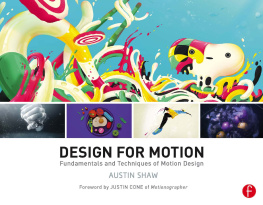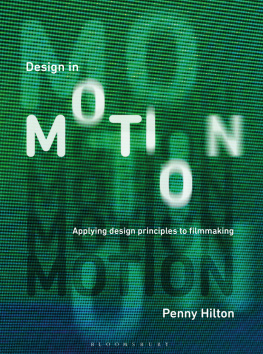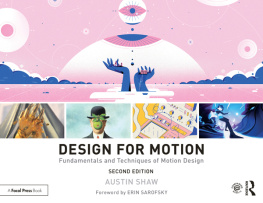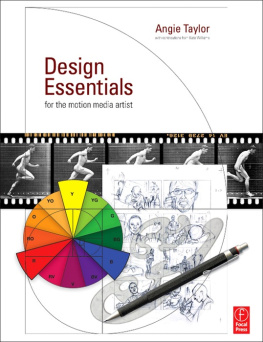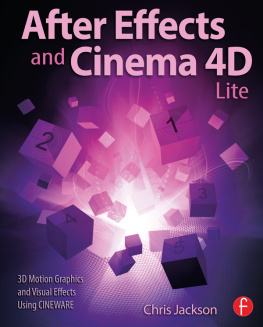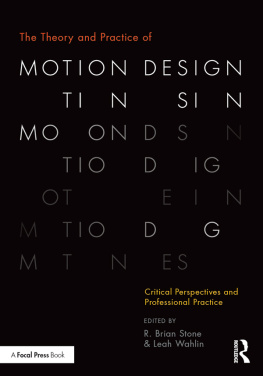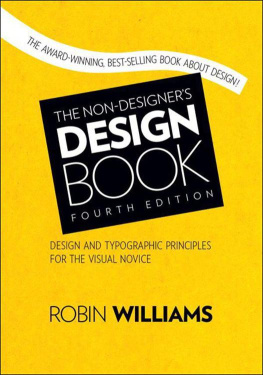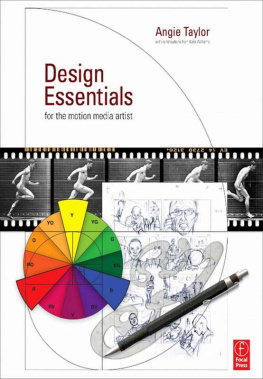The right of Austin Shaw to be identied as author of this work has been asserted by him in accordance with sections 77 and 78 of the Copyright, Designs and Patents Act 1988.
All rights reserved. No part of this book may be reprinted or reproduced or utilised in any form or by any electronic, mechanical, or other means, now known or hereafter invented, including photocopying and recording, or in any information storage or retrieval system, without permission in writing from the publishers.
Trademark notice: Product or corporate names may be trademarks or registered trademarks, and are used only for identication and explanation without intent to infringe.
Shaw, Austin.
Design for Motion: Motion Design Techniques & Fundamentals / written by Austin Shaw. pages cm
1. Computer animation--Study and teaching (Higher) 2. Computer graphics--Study and teaching (Higher) 3. Animation (Cinematography--Study and teaching (Higher) 4. Television graphics--Study and teaching (Higher) I. Title. TR897.7.S3885 2015
Cover Images Courtesy of Yeojin Shin, Gentleman Scholar, Audrey Yeo, Hyungsoon Joo, Junki Seoung, Daniel Uribe, and Sekani Solomon
Dedication
This book is dedicated to my daughters Athena Blue and Chloe Shaw, who remind me to be curious. And, to my father Larry Shaw, who always believed in my words.
Contents
viii Contents
Contents ix
x Contents
Contents xi
Contributors xiii
Contributors
Professional Perspectives Industry Contributors
Beat Baudenbacher
William Campbell
Patrick Clair
Lindsay Daniels
Bran Dougherty-Johnson Karin Fong
Chace Hartman
Lauren Hartstone
Greg Herman
Will Hyde
Will Johnson
Kylie Matulick
Bradley G Munkowitz (GMUNK) Daniel Oefnger
Robert Rugan
Erin Sarofsky
Matt Smithson
Carlo Vega
Alan Williams
Danny Yount
Lucas Zanotto
Additional Professional Contributors
Evan Goodell
Nath Milburn
Paige Striebig
Student Contributors Joe Ball
Nathan Boyd Vanessa Brown Daniel Chang
Peter Clark
CJ Cook
David Conklin Casey Crisenbury Jason M. Diaz
Eric Dies
Jackie Khanh Doan Gautam Dutta Taylor English Kalin Fields
Chris Finn
Rainy Fu
Ben Gabelman Preston Gibson Caresse Haaser Chase Hochstatter John Hughes
Sarah Beth Hulver Dominica Jane Jordan Rick Kuan
Hyemin Hailey Lee Scott Cheng Yi Lim Ana Cristina Lossada Jordan Lyle
Nick Lyons
Stasia Luo
Madeline Miller Alonna Morrison Robert Morrison Jr. Eddy Nieto
Sara Odze
Lauren Peterson Raffael Pindell Patrick Pohl
Lexie Redd
Graham Reid Ryan Brady Rish Chris Salvador Keliang Shan Yeojin Shin Sekani Solomon Jordan Taylor Daniel Uribe Audrey Yeo
Faculty Contributors Michael Betancourt
John Colette Dominique Mertens Elliot James Gladman
Minho Shin
Woon (Duff) Yong
Foreword xv
Foreword
Justin Cone
Something subtle but revolutionary happened over the last decade. No one noticed, but it happened in plain sight, on blogs and social media and on stages at conferences around the world. An accepted term used by thousands of designers and lmmakers quietly shed its skin and did something marvelous: it matured.
The term was motion graphics, an awkward, always plural construction in heavy use by lmmakers and broadcasters with roots that snake back to at least the 1960s. While the term is still in use today, its rapidly giving way to its wiser and more relevant successor, motion design. That simple change is a silent earthquake, the shock waves of which will quietly upend communication practices across industries for decades to come.
How can a one-word change possibly matter so much? First, it helps to dene motion design, which turns out to be a complicated feat. Both motion design and motion graphics are derived from the same longer term: motion graphic design, a frustratingly vague concept.
Looked at one way, motion graphic design is about the design of graphics used in the context of moving images. A helpful example: designing a map that appears over the shoulder of a newscaster during the nightly news. In the parlance of broadcast television, the map is a graphic, a composite of
elements superimposed onto a stream of live-action
footage.
Theres nothing wrong with this denition of motion graphic design. Its accurate. But its also limiting. It runs dry long before describing everything motion design has become over the last 50 years or so. Theres another interpretation of motion design that turns out to be a fount of possibility. It requires a slight rearrangement of the words and the addition of a preposition so that you get graphic design in motion. This seemingly supercial change is the key to understanding the true power of the eld and why the book youre reading is a doorway to the future.
Graphic design rose to power in the twentieth century, when mass media and advertising combined to wallpaper the world with messaging of all kinds. While radio and television increasingly dominated the airwaves, graphic design dominated everything else, enjoying a kind of ubiquity previously unseen in the world. From packaging to billboards to periodicals, graphic design not only forced its way into everyones eld of vision, it also earned respect as a vocation. Graphic designers shared symposium panels and respected professorships with even the most revered practitioners of design: architects. While the latter specialized in the built world, graphic designers crafted worlds of
xvi Foreword
impossible. This book distills what we know so far. But its more than a shortcut through the wilderness. Its a reminder of the richness of motion design. There is perhaps no other eld that draws so heavily on such a wide variety of creative disciplines, including (but not limited to) painting, illustration, writing, graphic design, animation, lmmaking, visual effects, sound design, music composition, computer science, and, on occasion, choreography. The master motion designer has a deep, enduring appreciation for all of these disciplines and more.
* * *
I adore Milton Glaser. Famous for his iconic I NY visual slogan, he is one of the most prolic graphic designers of the last 100 years. His creations have adorned museum walls, lled textbooks, and papered city streets since the 1940s. But he really messed up back in 2012.
In an interview with Brendan Dawes, Mr. Glaser said: Someone asked me the other day what I do all day, and I said, I move things around until they look right. And I suspect that thats as good a denition of graphic design as I could come up with.
Taken out of context, this idea can save you tens of thousands of dollars. Why go to school when all you need to learn is how to move things around? There must be a tutorial online somewhere for learning to move things around!

